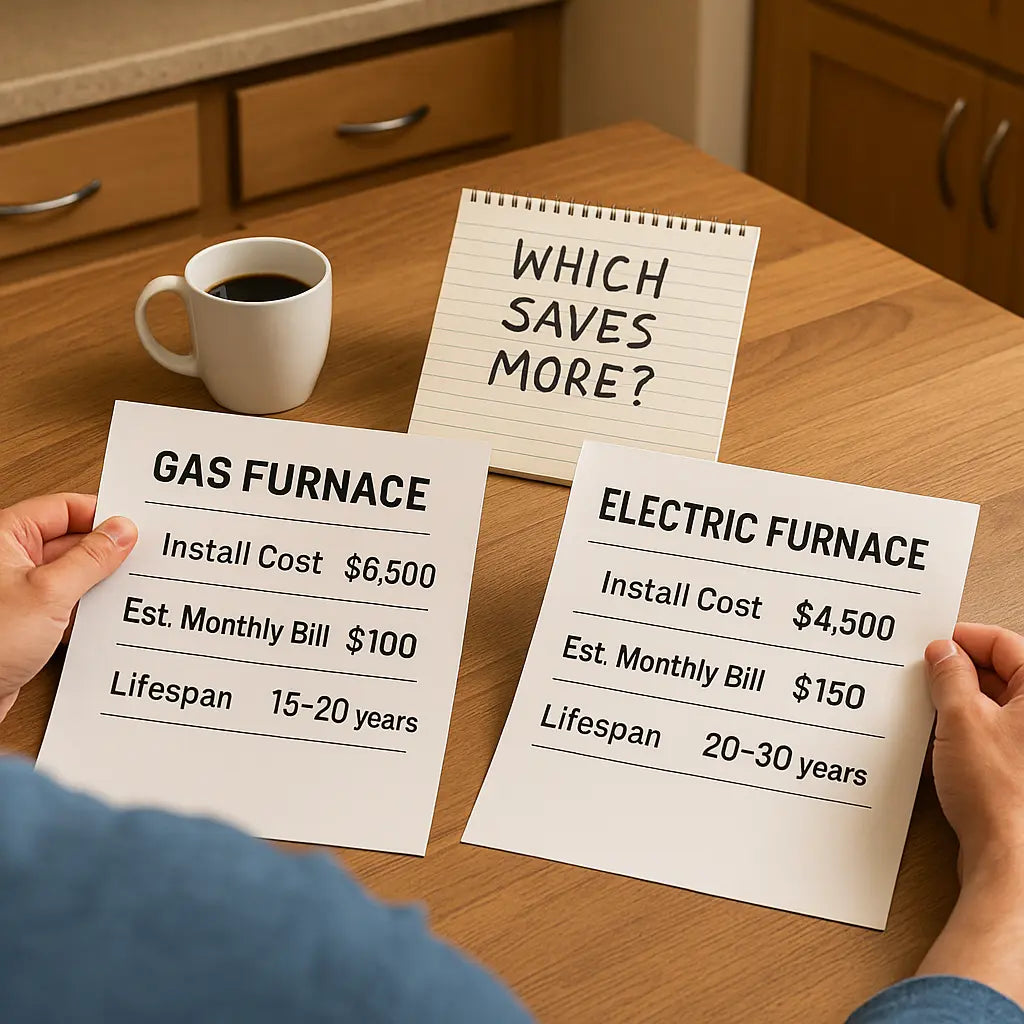Alex Lane here — your Home Comfort Advocate.
One of the biggest mistakes I see homeowners make when choosing a new furnace? Only comparing the price tag.
Sure, upfront costs matter. But if you really want to make a smart decision for your home (and your wallet), you have to look at total cost of ownership — from installation to energy bills to maintenance over time.
So let’s break it down: What are the true costs of owning a gas furnace vs. an electric one? And which one saves you more in the long run?
Upfront Costs: What You’ll Pay to Get Started
When it comes to installation, electric furnaces typically win on simplicity and price — especially in homes that already run on electric-only systems.
| Furnace Type | Equipment + Install | Notes |
|---|---|---|
| Gas Furnace | $4,500–$8,000 | May require gas line, venting, permits |
| Electric Furnace | $3,000–$6,000 | May require panel upgrade |
What Affects Installation Cost?
Several factors can drive your cost up or down:
-
Local building codes and permit requirements
-
Whether you’re replacing an old system or installing new
-
Access to existing gas lines or breaker capacity
For a deeper dive into installation variables, Energy.gov’s furnace guide breaks it down clearly.
Long-Term Operating Costs: Gas vs. Electric Bills
Here’s where the scales can shift — especially depending on your local utility rates and winter weather patterns.
According to the U.S. Energy Information Administration (EIA), natural gas is still significantly cheaper per BTU than electricity in most U.S. regions. That often makes gas cheaper to run, even if the equipment costs more upfront.
| Category | Gas Furnace | Electric Furnace |
|---|---|---|
| Fuel Cost per Month (avg.) | $75–$150 | $100–$200 |
| Efficiency | 80–98% AFUE | 95–100% AFUE |
| Maintenance | Moderate | Low |
Pro Tip: If you live in a mild climate or have rooftop solar, electric may edge out gas over time — especially with clean energy credits.
Maintenance, Repairs & Reliability
Gas Furnace Service Needs
Gas furnaces have more moving parts and combustion-related components. That means:
-
More frequent service (recommended annually)
-
Risk of issues like cracked heat exchangers or ignition failure
-
Carbon monoxide safety inspections required
Electric Furnace Service Needs
Electric units are simpler:
-
No combustion = fewer safety risks
-
No flue or gas lines to inspect
-
Fewer emergency repairs
According to Trane’s maintenance cost guide, gas furnace service typically runs $125–$250 per visit, while electric systems often just need periodic checks and cleanings.
Expected Lifespan & Replacement Costs
| Furnace Type | Average Lifespan | Common Repairs |
|---|---|---|
| Gas | 15–20 years | Igniter, venting, sensor faults |
| Electric | 20–30 years | Heating element burnout |
Because electric systems don’t handle fuel combustion or flue gases, they typically last longer — up to 30 years with proper use. Gas systems still offer reliable service, but may wear out sooner due to internal heat and moving parts.
Rebates, Incentives & Electrification Credits
Don’t overlook what you can get back when you upgrade. Between federal tax credits, state incentives, and utility rebates, switching to a high-efficiency system can come with serious savings.
Electric Furnace Incentives
-
Federal tax credits up to $600 on Energy Star-certified electric furnaces
-
Electrification rebates (available in CA, NY, MA, and more)
-
Bonus incentives when paired with solar or heat pump systems
Gas Furnace Incentives
-
Still eligible for tax credits when rated 95%+ AFUE
-
Often bundled in utility energy efficiency programs
You can find an updated breakdown at EnergyStar’s rebate center.
10-Year Cost Comparison Table
Let’s say you’re heating a 2,000 sq ft home in a moderate climate. Here’s a rough comparison over a 10-year period:
| Category | Gas Furnace | Electric Furnace |
|---|---|---|
| Upfront Cost | $6,500 | $4,500 |
| Energy Bills (est.) | $11,000 | $15,000 |
| Maintenance | $2,000 | $800 |
| Expected Lifespan | 15–20 years | 20–30 years |
| 10-Year Total | $19,500 | $20,300 |
Conclusion?
In cold climates, gas still edges out on operating cost. But in warm states — or homes with solar — electric is becoming a smart long-term bet.
So, Which Costs Less Over Time?
There’s no one-size-fits-all answer. But here’s how I advise most homeowners:
Choose Gas Furnace If:
-
You live in a cold climate
-
You already have a gas hookup
-
You want lower heating bills short term
Choose Electric Furnace If:
-
You live in a mild to moderate climate
-
You want lower maintenance and a longer system life
-
You’re planning to go solar or all-electric
And if you're still on the fence, consider hybrid setups — they’re growing fast in 2025.
Ready to Compare Your Options?
Don’t just guess your way into a major HVAC decision. When you understand how upfront costs, utility bills, and system lifespans fit together, you can save thousands over the next decade.
👉 Head back to our Gas vs. Electric Furnaces: Which Is Better? guide for the full breakdown, or keep reading next with
👉 Energy Efficiency Showdown: Which Furnace Type Saves More?
Alex Lane
Your Home Comfor Advocate







